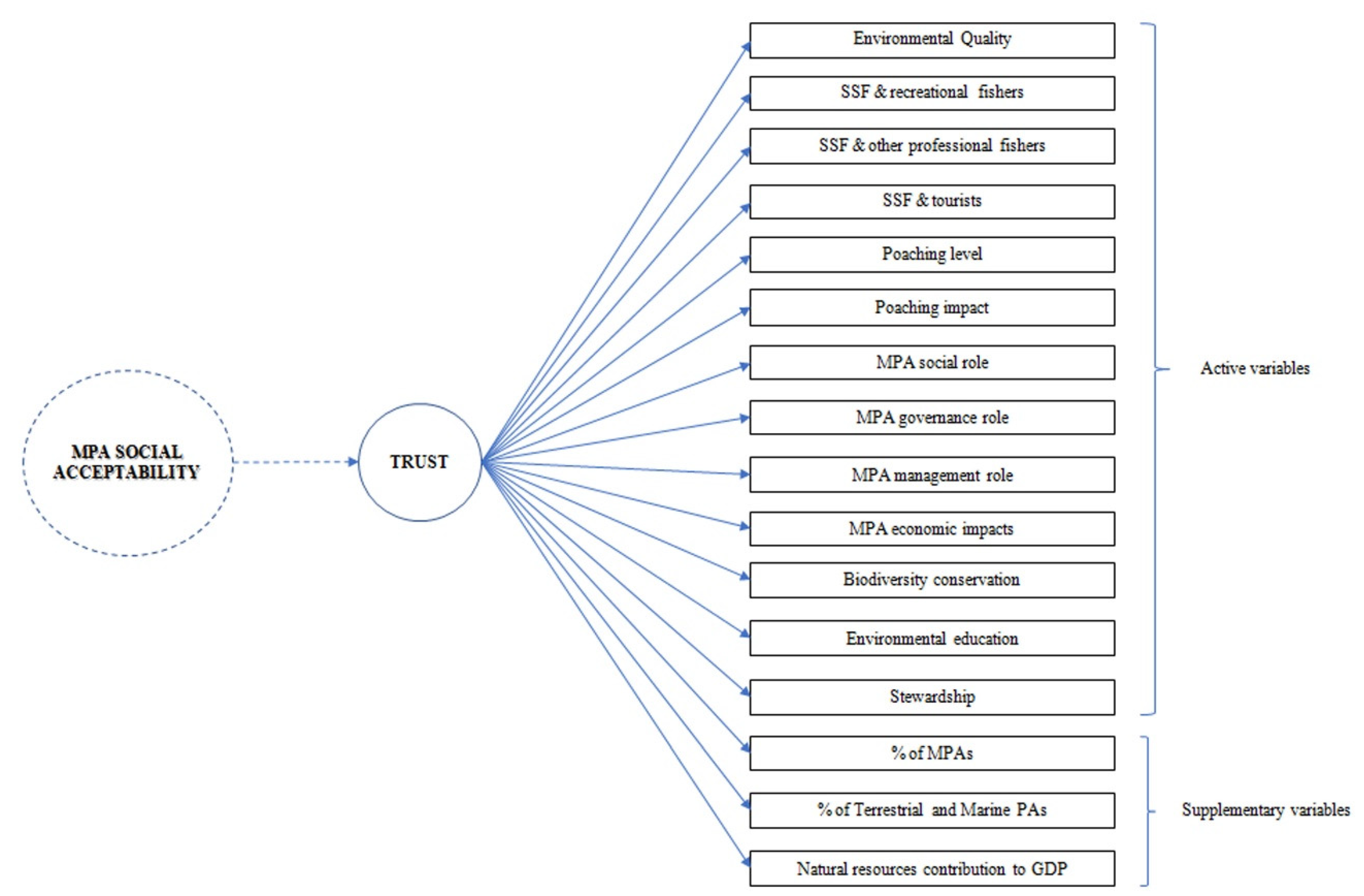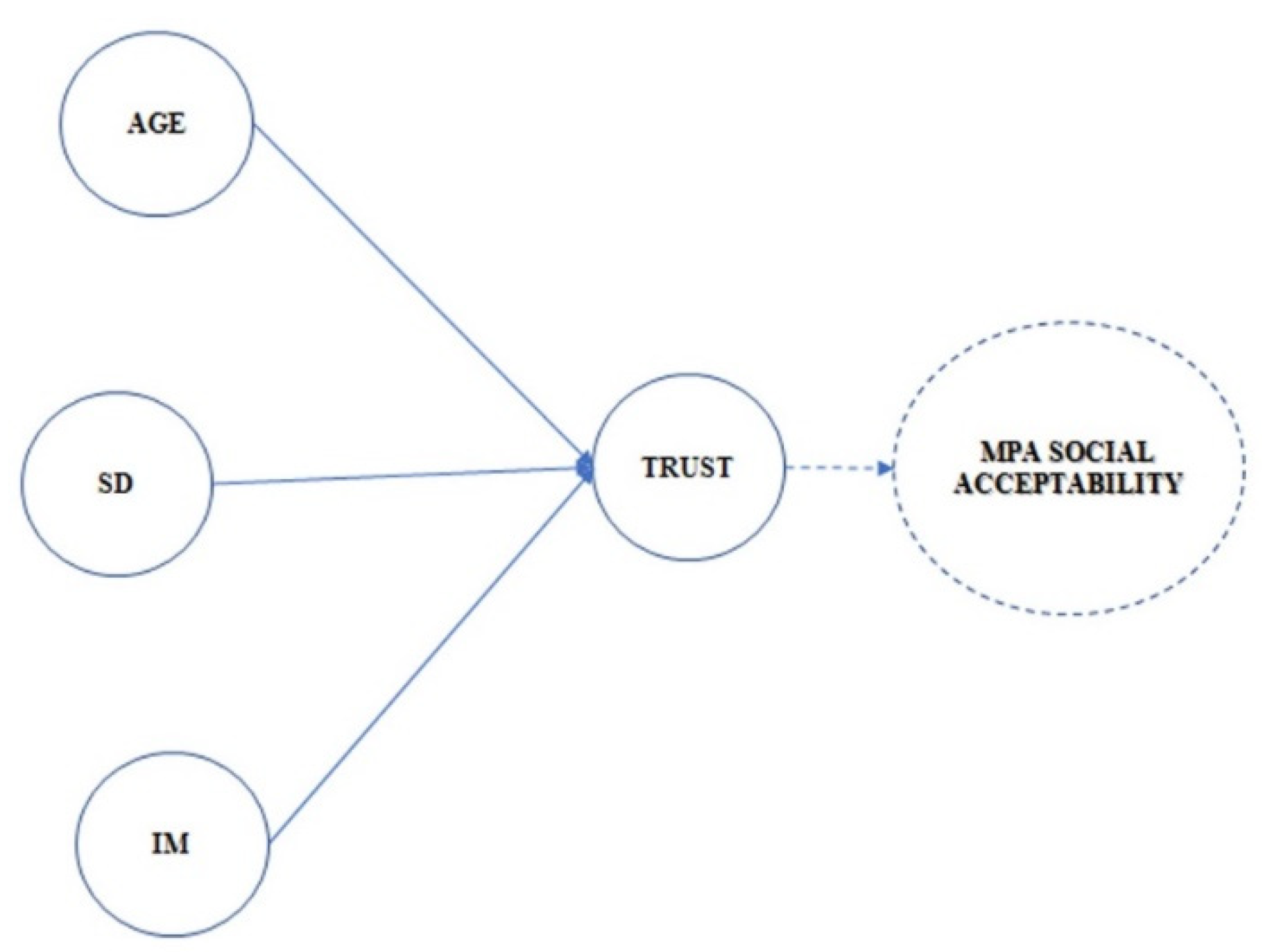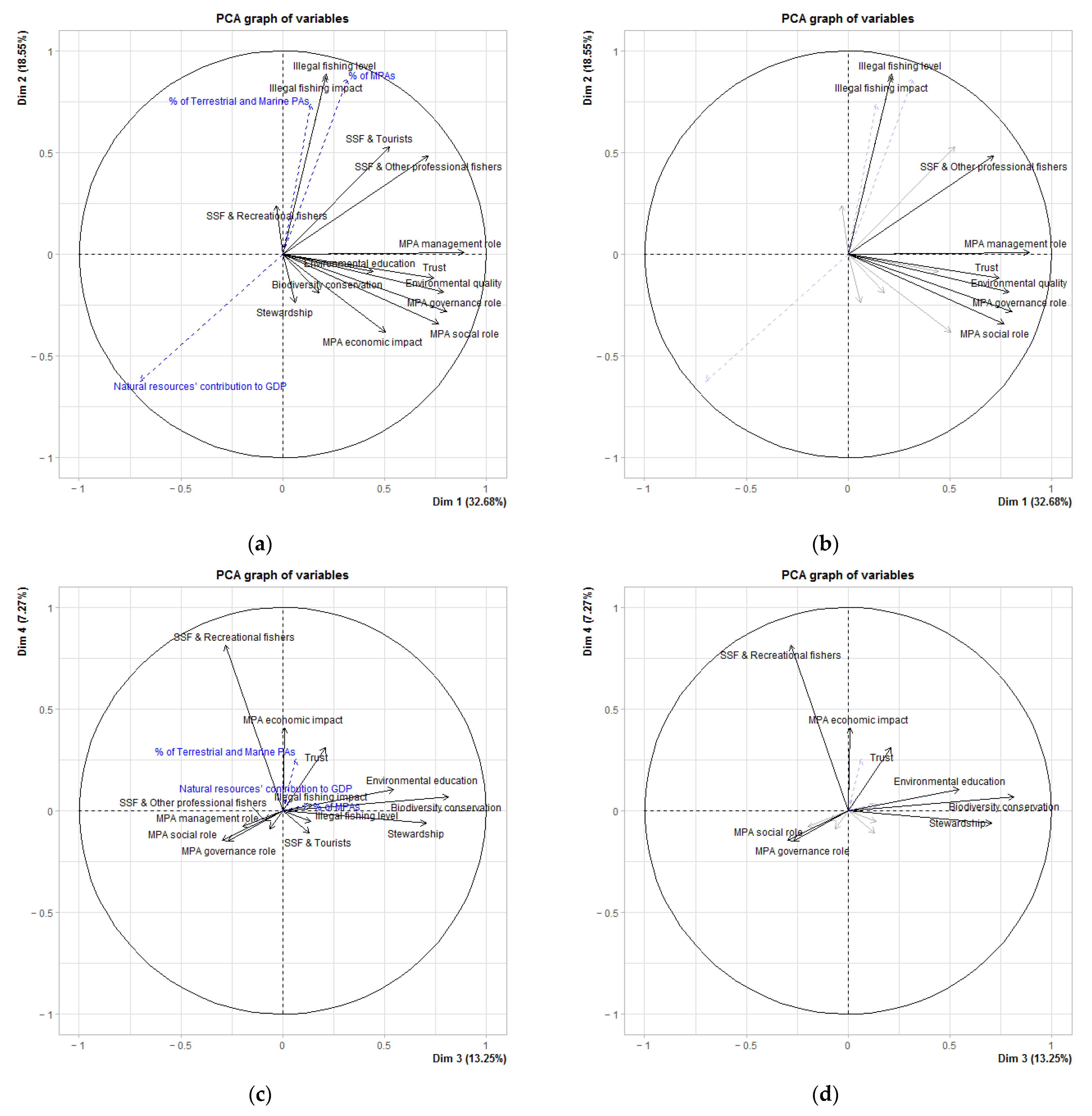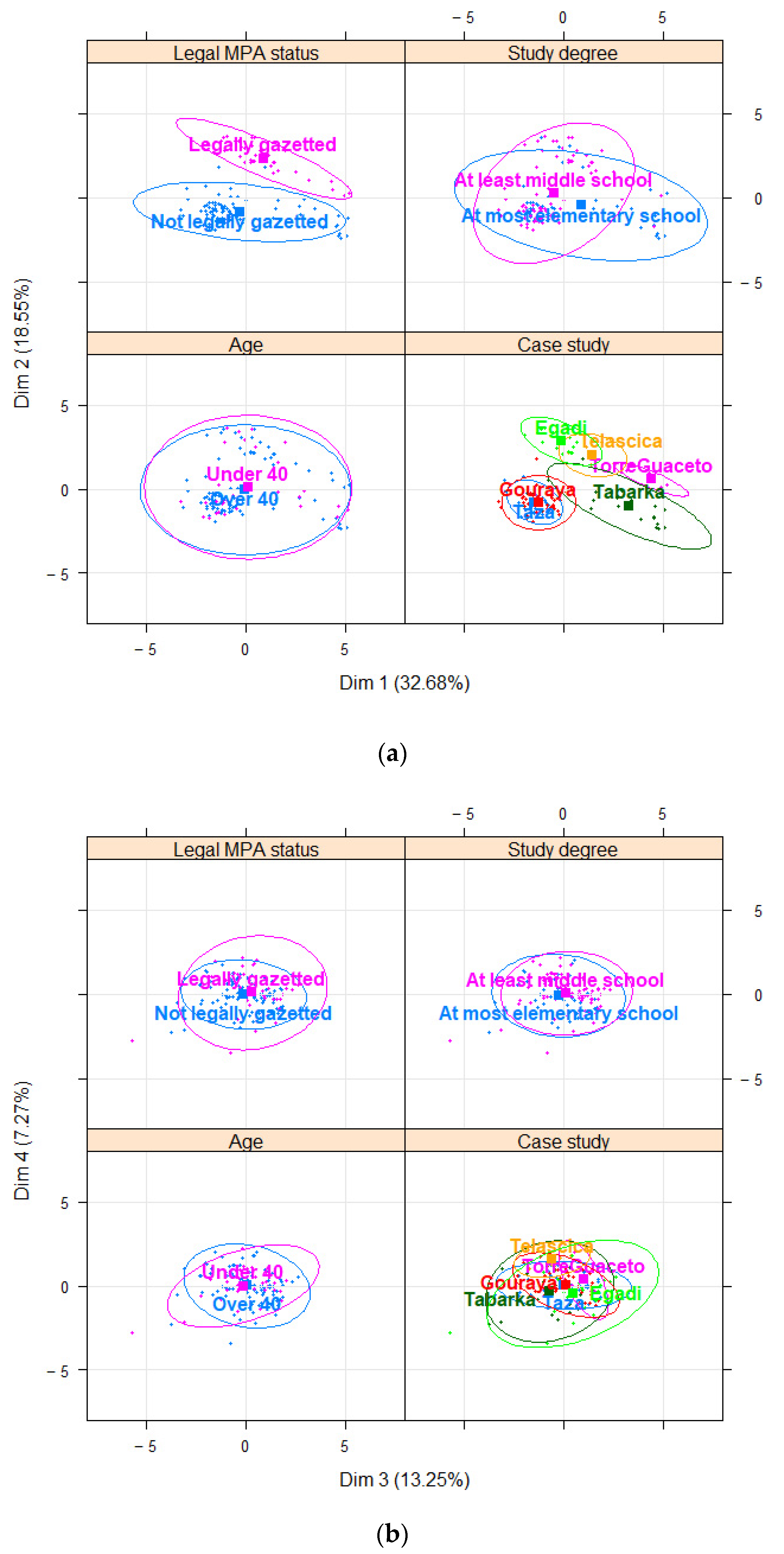Drivers of Small-Scale Fishers’ Acceptability across Mediterranean Marine Protected Areas at Different Stages of Establishment
Abstract
1. Introduction
2. Materials and Methods
2.1. Research Context and Study Design
2.2. Data Analysis
3. Results
3.1. Sample Characteristics
3.2. Assessing MPA Social Acceptability
3.3. Predictors of MPA Social Acceptability
4. Discussion
5. Conclusions
Supplementary Materials
Author Contributions
Funding
Institutional Review Board Statement
Informed Consent Statement
Data Availability Statement
Conflicts of Interest
References
- Bruno, J.F.; Bates, A.E.; Cacciapaglia, C.; Pike, E.P.; Amstrup, S.C.; van Hooidonk, R.; Henson, S.A.; Aronson, R.B. Climate change threatens the world’s marine protected areas. Nat. Clim. Chang. 2018, 8, 499–503. [Google Scholar] [CrossRef]
- Di Franco, A.; Plass-Johnson, J.G.; Di Lorenzo, M.; Meola, B.; Claudet, J.; Gaines, S.D.; García-Charton, J.A.; Giakoumi, S.; Grorud-Colvert, K.; Hackradt, C.W.; et al. Linking home ranges to protected area size: The case study of the Mediterranean Sea. Biol. Conserv. 2018, 221, 175–181. [Google Scholar] [CrossRef]
- Fox, H.; Soltanoff, C.S.; Mascia, M.; Haisfield, K.M.; Lombana, A.V.; Pyke, C.R.; Wood, L. Explaining global patterns and trends in marine protected area (MPA) development. Mar. Policy 2012, 36, 1131–1138. [Google Scholar] [CrossRef]
- Gill, D.A.; Mascia, M.B.; Ahmadia, G.N.; Glew, L.; Lester, S.E.; Barnes, M.; Craigie, I.; Darling, E.S.; Free, C.M.; Geldmann, J.; et al. Capacity shortfalls hinder the performance of marine protected areas globally. Nature 2017, 543, 665–669. [Google Scholar] [CrossRef] [PubMed]
- Scianna, C.; Niccolini, F.; Giakoumi, S.; Di Franco, A.; Gaines, S.D.; Bianchi, C.N.; Scaccia, L.; Bava, S.; Cappanera, V.; Charbonnel, E.; et al. Organization Science improves management effectiveness of Marine Protected Areas. J. Environ. Manag. 2019, 240, 285–292. [Google Scholar] [CrossRef] [PubMed]
- Di Franco, A.; Thiriet, P.; Di Carlo, G.; Dimitriadis, C.; Francour, P.; Gutiérrez, N.L.; de Grissac, A.J.; Koutsoubas, D.; Milazzo, M.; Otero, M.D.M.; et al. Five key attributes can increase marine protected areas performance for small-scale fisheries management. Sci. Rep. 2016, 6, 38135. [Google Scholar] [CrossRef]
- Grorud-Colvert, K.; Sullivan-Stack, J.; Roberts, C.; Constant, V.; e Costa, B.H.; Pike, E.P.; Kingston, N.; Laffoley, D.; Sala, E.; Claudet, J.; et al. The MPA Guide: A framework to achieve global goals for the ocean. Science 2021, 373, eabf0861. [Google Scholar] [CrossRef]
- Hattam, C.; Mangi, S.; Gall, S.; Rodwell, L. Social impacts of a temperate fisheries closure: Understanding stakeholders’ views. Mar. Policy 2014, 45, 269–278. [Google Scholar] [CrossRef]
- Kerwath, S.E.; Winker, H.; Götz, A.; Attwood, C.G. Marine protected area improves yield without disadvantaging fishers. Nat. Commun. 2013, 4, 2347. [Google Scholar] [CrossRef]
- Sala, E.; Mayorga, J.; Bradley, D.; Cabral, R.B.; Atwood, T.B.; Auber, A.; Cheung, W.; Costello, C.; Ferretti, F.; Friedlander, A.M.; et al. Protecting the global ocean for biodiversity, food and climate. Nature 2021, 592, 397–402. [Google Scholar] [CrossRef]
- Sala, E.; Costello, C.; Dougherty, D.; Heal, G.; Kelleher, K.; Murray, J.H.; Rosenberg, A.A.; Sumaila, R. A General Business Model for Marine Reserves. PLoS ONE 2013, 8, e58799. [Google Scholar] [CrossRef] [PubMed]
- Lubchenco, J.; Grorud-Colvert, K. Making waves: The science and politics of ocean protection. Science 2015, 350, 382–383. [Google Scholar] [CrossRef] [PubMed]
- Jentoft, S.; Pascual-Fernandez, J.J.; Modino, R.D.L.C.; Gonzalez-Ramallal, M.; Chuenpagdee, R. What Stakeholders Think about Marine Protected Areas: Case Studies from Spain. Hum. Ecol. 2012, 40, 185–197. [Google Scholar] [CrossRef]
- Voyer, M.; Gladstone, W.; Goodall, H. Obtaining a social licence for MPAs—influences on social acceptability. Mar. Policy 2015, 51, 260–266. [Google Scholar] [CrossRef]
- Bennett, N.J. Using perceptions as evidence to improve conservation and environmental management. Conserv. Biol. 2016, 30, 582–592. [Google Scholar] [CrossRef]
- Bennett, N.J.; Di Franco, A.; Calò, A.; Nethery, E.; Niccolini, F.; Milazzo, M.; Guidetti, P. Local support for conservation is associated with perceptions of good governance, social impacts, and ecological effectiveness. Conserv. Lett. 2019, 12, e12640. [Google Scholar] [CrossRef]
- Charles, A.; Wilson, L. Human dimensions of Marine Protected Areas. ICES J. Mar. Sci. 2009, 66, 6–15. [Google Scholar] [CrossRef]
- Di Franco, A.; Hogg, K.E.; Calò, A.; Bennet, N.J.; Sévin-Allouet, M.A.; Alaminos, O.E.; Lang, M.; Kkoutsoubas, D.; Prvan, M.; Santarossa, L.; et al. Improving marine protected area governance through collab-oration and co-production. J. Environ. Manag. 2020, 269, 110757. [Google Scholar] [CrossRef]
- Bennett, N.J.; Dearden, P. Why local people do not support conservation: Community perceptions of marine protected area livelihood impacts, governance and management in Thailand. Mar. Policy 2014, 44, 107–116. [Google Scholar] [CrossRef]
- Bennett, N.J.; Roth, R.; Klain, S.C.; Chan, K.; Christie, P.; Clark, D.A.; Cullman, G.; Curran, D.; Durbin, T.J.; Epstein, G.; et al. Conservation social science: Understanding and integrating human dimensions to improve conservation. Biol. Conserv. 2017, 205, 93–108. [Google Scholar] [CrossRef]
- Gallacher, J.; Simmonds, N.; Fellowes, H.; Brown, N.; Gill, N.; Clark, W.; Biggs, C.; Rodwell, L. Evaluating the success of a marine protected area: A systematic review approach. J. Environ. Manag. 2016, 183, 280–293. [Google Scholar] [CrossRef] [PubMed]
- McNeill, A.; Clifton, J.; Harvey, E.S. Attitudes to a marine protected area are associated with perceived social impacts. Mar. Policy 2018, 94, 106–118. [Google Scholar] [CrossRef]
- Micheli, F.; Niccolini, F. Achieving Success under Pressure in the Conservation of Intensely Used Coastal Areas. Ecol. Soc. 2013, 18, 19. [Google Scholar] [CrossRef]
- Rossiter, J.S.; Levine, A. What makes a “successful” marine protected area? The unique context of Hawaii′s fish replenishment areas. Mar. Policy 2014, 44, 196–203. [Google Scholar] [CrossRef]
- Guidetti, P.; Milazzo, M.; Bussotti, S.; Molinari, A.; Murenu, M.; Pais, A.; Spanò, N.; Balzano, R.; Agardy, T.; Boero, F.; et al. Italian marine reserve effectiveness: Does enforcement matter? Biol. Conserv. 2008, 141, 699–709. [Google Scholar] [CrossRef]
- Jennings, S. The role of marine protected areas in environmental management. ICES J. Mar. Sci. 2009, 66, 16–21. [Google Scholar] [CrossRef]
- Jones, N.; McGinlay, J.; Dimitrakopoulos, P.G. Improving social impact assessment of protected areas: A review of the literature and directions for future research. Environ. Impact Assess. Rev. 2017, 64, 1–7. [Google Scholar] [CrossRef]
- Claudet, J.; Guidetti, P. Improving assessments of marine protected areas. Aquat. Conserv. Mar. Freshw. Ecosyst. 2010, 20, 239–242. [Google Scholar] [CrossRef]
- Read, A.D.; West, R.J.; Haste, M.; Jordan, A. Optimizing voluntary compliance in marine protected areas: A comparison of recreational fisher and enforcement officer perspectives using multi-criteria analysis. J. Environ. Manag. 2011, 92, 2558–2567. [Google Scholar] [CrossRef]
- Dimech, M.; Darmanin, M.; Smith, I.P.; Kaiser, M.J.; Schembri, P.J. Fishers’ perception of a 35-year old exclusive Fisheries Management Zone. Biol. Conserv. 2009, 142, 2691–2702. [Google Scholar] [CrossRef]
- McCLANAHAN, T.; Cinner, J.; Kamukuru, A.; Abunge, C.; Ndagala, J. Management preferences, perceived benefits and conflicts among resource users and managers in the Mafia Island Marine Park, Tanzania. Environ. Conserv. 2008, 35, 340–350. [Google Scholar] [CrossRef]
- Silva, M.R.; Lopes, P.F. Each fisherman is different: Taking the environmental perception of small-scale fishermen into account to manage marine protected areas. Mar. Policy 2015, 51, 347–355. [Google Scholar] [CrossRef]
- Heck, N.; Dearden, P.; McDonald, A. Stakeholders’ expectations towards a proposed marine protected area: A multi-criteria analysis of MPA performance criteria. Ocean Coast. Manag. 2011, 54, 687–695. [Google Scholar] [CrossRef]
- Miles, A.; Perea Mũnoz, J.M.; Bayle-Sampere, J.T. Low satisfaction and failed relational coordination among relevant stakeholders in Spanish Mediterranean marine protected areas. J. Environ. Manag. 2020, 272, 111003. [Google Scholar] [CrossRef]
- Arias, A.; Cinner, J.E.; Jones, R.E.; Pressey, R.L. Levels and drivers of fishers’ compliance with marine protected areas. Ecol. Soc. 2015, 20, 14. [Google Scholar] [CrossRef]
- Coppa, S.; Pronti, A.; Massaro, G.; Brundu, R.; Camedda, A.; Palazzo, L.; Nobile, G.; Pagliarino, E.; de Lucia, G.A. Fishery management in a marine protected area with compliance gaps: Socio-economic and biological insights as a first step on the path of sustainability. J. Environ. Manag. 2021, 280, 111754. [Google Scholar] [CrossRef]
- Gall, S.C.; Rodwell, L.D. Evaluating the social acceptability of Marine Protected Areas. Mar. Policy 2016, 65, 30–38. [Google Scholar] [CrossRef]
- Yates, K.L.; Clarke, B.; Thurstan, R.H. Purpose vs performance: What does marine protected area success look like? Environ. Sci. Policy 2019, 92, 76–86. [Google Scholar] [CrossRef]
- Thomassin, A.; White, C.S.; Stead, S.S.; David, G. Social acceptability of a marine protected area: The case of Reunion Island. Ocean Coast. Manag. 2010, 53, 169–179. [Google Scholar] [CrossRef]
- Hogg, K.; Noguera-Méndez, P.; Semitiel-García, M.; Gray, T.; Young, S. Controversies over stakeholder participation in marine protected area (MPA) management: A case study of the Cabo de Palos-Islas Hormigas MPA. Ocean Coast. Manag. 2017, 144, 120–128. [Google Scholar] [CrossRef]
- Rodríguez-Martínez, R. Community involvement in marine protected areas: The case of Puerto Morelos reef, México. J. Environ. Manag. 2008, 88, 1151–1160. [Google Scholar] [CrossRef] [PubMed]
- Kelly, R.; Fleming, A.; Mackay, M.; García, C.; Pecl, G.T. Social licence for marine protected areas. Mar. Policy 2020, 115, 103782. [Google Scholar] [CrossRef]
- Hamilton, M. Perceptions of fishermen towards marine protected areas in Cambodia and the Philippines. Biosci. Horiz. 2012, 5, hzs007. [Google Scholar] [CrossRef]
- Leleu, K.; Alban, F.; Pelletier, D.; Charbonnel, E.; Letourneur, Y.; Boudouresque, C.F. Fishers’ perceptions as indicators of the performance of Marine Protected Areas (MPAs). Mar. Policy 2012, 36, 414–422. [Google Scholar] [CrossRef]
- Richardson, E.A.; Kaiser, M.J.; Edwards-Jones, G. Variation in fishers’ attitudes within an inshore fishery: Implications for management. Environ. Conserv. 2005, 32, 213–225. [Google Scholar] [CrossRef]
- Tzanatos, E.; Dimitriou, E.; Papaharisis, L.; Roussi, A.; Somarakis, S.; Koutsikopoulos, C. Principal socio-economic characteristics of the Greek small-scale coastal fishermen. Ocean Coast. Manag. 2006, 49, 511–527. [Google Scholar] [CrossRef]
- Pita, C.; Piearce, G.J.; Theodossiou, I. Stakeholders’ participation in the fisheries management decision-making process: Fishers’ perceptions of participation. Mar. Policy 2010, 34, 1093–1102. [Google Scholar] [CrossRef]
- Launio, C.C.; Morooka, Y.; Aizaki, H.; Iiguni, Y. Perceptions of small-scale fishermen on the value of marine resources and protected areas: Case of Claveria, Northern Philippines. Int. J. Sustain. Dev. World Ecol. 2010, 17, 401–409. [Google Scholar] [CrossRef]
- Gelcich, S.; Godoy, N.; Castilla, J.C. Artisanal fishers’ perceptions regarding coastal co-management policies in Chile and their potentials to scale-up marine biodiversity conservation. Ocean Coast. Manag. 2009, 52, 424–432. [Google Scholar] [CrossRef]
- Russ, G.R.; Alcala, A.C.; Maypa, A.P. Spillover from marine reserves: The case of Naso vlamingii at Apo Island, the Philippines. Mar. Ecol. Prog. Ser. 2003, 264, 15–20. [Google Scholar] [CrossRef]
- Niccolini, F.; Marzo, D.; Scipioni, S.; Randone, M.; Hogg, K.; Gomei, M. Ecosystem Services, Socio-Economic Values and Organizational Profiles of Mediterranean Marine Protected Areas; WWF: Rome, Italy, 2019. [Google Scholar]
- Hogg, K.; Noguera-Méndez, P.; Semitiel-García, M.; Giménez-Casalduero, M. Marine protected area governance: Prospects for co-management in the European Mediterranean. Adv. Oceanogr. Limnol. 2013, 4, 241–259. [Google Scholar] [CrossRef]
- Gomei, M.; Abdulla, S.A.; Schröder, C.; Yadav, S.; Sánchez, A.; Rodriguez, D.; Abdul Malak, D. Towards 2020: How Mediterranean Countries are Performing to Protected their Sea; WWF: Rome, Italy, 2019. [Google Scholar]
- Lunn, K.E.; Dearden, P. Fishers’ Needs in Marine Protected Area Zoning: A Case Study from Thailand. Coast. Manag. 2006, 34, 183–198. [Google Scholar] [CrossRef]
- Kockel, A.; Ban, N.C.; Costa, M.; Dearden, P. Evaluating approaches for scaling-up community-based marine-protected areas into socially equitable and ecologically representative networks. Conserv. Biol. 2019, 34, 137–147. [Google Scholar] [CrossRef] [PubMed]
- FAO. The Regional Plan of Action for Small-Scale Fisheries in the Mediterranean and the Black Sea; General Fisheries Commission for the Mediterranean; FAO: Rome, Italy, 2021. [Google Scholar]
- FAO. The State of Mediterranean and Black Sea Fisheries; General Fisheries Commission for the Mediterranean; FAO: Rome, Italy, 2022. [Google Scholar] [CrossRef]
- Smith, H.; Basurto, X. Defining Small-Scale Fisheries and Examining the Role of Science in Shaping Perceptions of Who and What Counts: A Systematic Review. Front. Mar. Sci. 2019, 6, 236. [Google Scholar] [CrossRef]
- Bennett, N.J.; Calò, A.; Di Franco, A.; Niccolini, F.; Marzo, D.; Domina, I.; Dimitriadis, C.; Sobrado, F.; Santoni, M.-C.; Charbonnel, E.; et al. Social equity and marine protected areas: Perceptions of small-scale fishermen in the Mediterranean Sea. Biol. Conserv. 2020, 244, 108531. [Google Scholar] [CrossRef]
- Jimenez, A.; Gonzalez, J.G.; Amaral, M.T.; Frédou, F.L. Sustainability indicators for the integrated assessment of coastal small-scale fisheries in the Brazilian Amazon. Ecol. Econ. 2021, 181, 106910. [Google Scholar] [CrossRef]
- Bollen, K.A. Latent Variables in Psychology and the Social Sciences. Annu. Rev. Psychol. 2002, 53, 605–634. [Google Scholar] [CrossRef]
- Dare, M.; Schirmer, J.; Vanclay, F. Community engagement and social licence to operate. Impact Assess. Proj. Apprais. 2014, 32, 188–197. [Google Scholar] [CrossRef]
- Jones, N.; Clark, J.; Panteli, M.; Proikaki, M.; Dimitrakopoulos, P. Local social capital and the acceptance of Protected Area policies: An empirical study of two Ramsar river delta ecosystems in northern Greece. J. Environ. Manag. 2012, 96, 55–63. [Google Scholar] [CrossRef]
- McEvily, B.; Perrone, V.; Zaheer, A. Trust as an Organizing Principle. Organ. Sci. 2003, 14, 91–103. [Google Scholar] [CrossRef]
- Rees, S.E.; Rodwell, L.D.; Searle, S.; Bell, A. Identifying the issues and options for managing the social impacts of Marine Protected Areas on a small fishing community. Fish. Res. 2013, 146, 51–58. [Google Scholar] [CrossRef]
- Davis, T.R.; Harasti, D. Predictive modelling of illegal fishing in no-take marine protected areas. Fish. Manag. Ecol. 2020, 27, 292–301. [Google Scholar] [CrossRef]
- Thiault, L.; Weekers, D.; Curnock, M.; Marshall, N.; Pert, P.L.; Beeden, R.; Dyer, M.; Claudet, J. Predicting poaching risk in marine protected areas for improved patrol efficiency. J. Environ. Manag. 2020, 254, 109808. [Google Scholar] [CrossRef]
- Castello, L.; Viana, J.P.; Watkins, G.; Pinedo-Vasquez, M.; Luzadis, V.A. Lessons from Integrating Fishers of Arapaima in Small-Scale Fisheries Management at the Mamirauá Reserve, Amazon. Environ. Manag. 2009, 43, 197–209. [Google Scholar] [CrossRef] [PubMed]
- Mangi, S.C.; Austen, M.C. Perceptions of stakeholders towards objectives and zoning of marine-protected areas in southern Europe. J. Nat. Conserv. 2008, 16, 271–280. [Google Scholar] [CrossRef]
- Pascual, M.; Rossetto, M.; Ojea, E.; Milchakova, N.; Giakoumi, S.; Kark, S.; Korolesova, D.; Melià, P. Socioeconomic impacts of marine protected areas in the Mediterranean and Black Seas. Ocean Coast. Manag. 2016, 133, 1–10. [Google Scholar] [CrossRef]
- World Bank. World Development Indicators. 2019. Available online: http://datatopics.worldbank.org/world-development-indicators/ (accessed on 10 March 2020).
- R Core Team. R: A Language and Environment for Statistical Computing; R Foundation for Statistical Computing: Vienna, Austria, 2019; Available online: https://www.R-project.org/ (accessed on 5 July 2021).
- Himes-Cornell, A. Small-Scale Sicilian Fisheries: Opinions of Artisanal Fishers and Sociocultural Effects in Two MPA Case Studies. Coast. Manag. 2003, 31, 389–408. [Google Scholar] [CrossRef]
- Maestro, M.; Chica-Ruiz, J.A.; Popović Perković, Z.; Pérez-Cayeiro, M.L. Marine Protected Areas Management in the Mediterranean Sea—The case of Croatia. Diversity 2002, 14, 448. [Google Scholar] [CrossRef]
- Magaš, D. Nature Park “Telašćica” on Dugi otok (Croatia)—Some aspects of environmental planning. Geoadria 1998, 3, 81–92. [Google Scholar] [CrossRef]
- Hatcher, A.; Jaffry, S.; Thebaud, O.; Bennett, E. Normative and Social Influences Affecting Compliance with Fishery Regulations. Land Econ. 2000, 76, 448–461. [Google Scholar] [CrossRef]
- Liao, C.-P.; Huang, H.-W.; Lu, H.-J. Fishermen’s perceptions of coastal fisheries management regulations: Key factors to rebuilding coastal fishery resources in Taiwan. Ocean Coast. Manag. 2019, 172, 1–13. [Google Scholar] [CrossRef]
- D’anna, G.; Fernández, T.V.; Pipitone, C.; Garofalo, G.; Badalamenti, F. Governance analysis in the Egadi Islands Marine Protected Area: A Mediterranean case study. Mar. Policy 2016, 71, 301–309. [Google Scholar] [CrossRef]
- Himes, A.H. Performance indicators in MPA management: Using questionnaires to analyze stakeholder preferences. Ocean Coast. Manag. 2007, 50, 329–351. [Google Scholar] [CrossRef]
- Di Lorenzo, M.; Claudet, J.; Guidetti, P. Spillover from marine protected areas to adjacent fisheries has an ecological and a fishery component. J. Nat. Conserv. 2016, 32, 62–66. [Google Scholar] [CrossRef]
- Prosperi, P.; Kirwan, J.; Maye, D.; Bartolini, F.; Vergamini, D.; Brunori, G. Adaptation strategies of small-scale fisheries within changing market and regulatory conditions in the EU. Mar. Policy 2019, 100, 316–323. [Google Scholar] [CrossRef]
- Russi, D. Governance strategies for a successful marine protected area—The case of Torre Guaceto. Mar. Policy 2020, 115, 103849. [Google Scholar] [CrossRef]






| Case Studies | Country | No. of Estimated Vessels * | No. (%) of Fishers Interviewed (Total = 124) |
|---|---|---|---|
| Egadi Islands | Italy | 40 | 21 (52%) |
| Torre Guaceto | Italy | 5 | 5 (100%) |
| Telašćica | Croatia | 15 | 7 (46%) |
| Gouraya | Algeria | 73 | 37 (50%) |
| Taza | Algeria | 54 | 34 (62%) |
| Tabarka | Tunisia | 36 | 20 (55%) |
| Variable a | Description b | Main References |
|---|---|---|
| Trust (proxy of MPA acceptability) | Positive assumption about motivations and intentions of the other part that affects the level of stakeholder support for management activity | [62,63,64] |
| Environmental quality | Perceptions about marine resource conditions and biodiversity | [32,39,43,44] |
| Relationship between SSF and recreational fishers | SSF perceptions about the relations and conflicts between resource users | [18,65] |
| Relationship between SSF and other professional fishers | ||
| Relationship between SSF and tourists | ||
| Level of illegal fishing | Perceptions about the major threats affecting SSF activities, such as illegal fishing | [66,67] |
| Illegal fishing impacts | ||
| MPA social role | Legitimacy of the social, governmental, and managerial roles of MPAs | [42,44,59] |
| MPA governance role | ||
| MPA management role | ||
| MPA economic impacts | ||
| Biodiversity conservation | Assessment of SSF support based on shared MPA goals | [6,51,68,69,70] |
| Environmental education | ||
| Stewardship |
| Variable | Total Sample (%) (N = 124) |
|---|---|
| Age | |
| 20–30 years old | 6 |
| 31–40 years old | 19 |
| 41–50 years old | 34 |
| 51–60 years old | 33 |
| 61+ years old | 6 |
| Missing values | 2 |
| Mean: 47 Standard deviation: 10 | |
| Study degree | |
| None | 12 |
| Elementary school | 23 |
| Middle school | 22 |
| High school | 34 |
| University/bachelor’s degree or higher | 7 |
| Missing values | 2 |
| Type of gears | |
| Trammel net/gillnet | 94 |
| Longlines (bottom and pelagic) | 44 |
| Traps | 8 |
| Lines | 3 |
| Other | 3 |
| Missing values | 6 |
| No. of people in household | |
| 1 | 9 |
| 2 | 9 |
| 3 | 8 |
| 4 | 36 |
| 5 | 25 |
| 6 | 8 |
| 7 | 2 |
| 8 | 1 |
| Missing values | 2 |
| Mean: 4 Standard deviation: 1 | |
| Variable | Categories | Mean of Trust | p-Value |
|---|---|---|---|
| Status | Legally gazetted | 3.45 | 0.092 |
| Non-legally gazetted | 3.14 | ||
| Age | ≤50 | 3.21 | 0.063 |
| >50 | 3.58 | ||
| Education | ≤Middle school | 3.4 | 0.766 |
| >Middle school | 3.29 |
Disclaimer/Publisher’s Note: The statements, opinions and data contained in all publications are solely those of the individual author(s) and contributor(s) and not of MDPI and/or the editor(s). MDPI and/or the editor(s) disclaim responsibility for any injury to people or property resulting from any ideas, methods, instructions or products referred to in the content. |
© 2023 by the authors. Licensee MDPI, Basel, Switzerland. This article is an open access article distributed under the terms and conditions of the Creative Commons Attribution (CC BY) license (https://creativecommons.org/licenses/by/4.0/).
Share and Cite
Marzo, D.; Cavallini, I.; Scaccia, L.; Guidetti, P.; Di Franco, A.; Calò, A.; Niccolini, F. Drivers of Small-Scale Fishers’ Acceptability across Mediterranean Marine Protected Areas at Different Stages of Establishment. Sustainability 2023, 15, 9138. https://doi.org/10.3390/su15119138
Marzo D, Cavallini I, Scaccia L, Guidetti P, Di Franco A, Calò A, Niccolini F. Drivers of Small-Scale Fishers’ Acceptability across Mediterranean Marine Protected Areas at Different Stages of Establishment. Sustainability. 2023; 15(11):9138. https://doi.org/10.3390/su15119138
Chicago/Turabian StyleMarzo, Daniela, Iacopo Cavallini, Luisa Scaccia, Paolo Guidetti, Antonio Di Franco, Antonio Calò, and Federico Niccolini. 2023. "Drivers of Small-Scale Fishers’ Acceptability across Mediterranean Marine Protected Areas at Different Stages of Establishment" Sustainability 15, no. 11: 9138. https://doi.org/10.3390/su15119138
APA StyleMarzo, D., Cavallini, I., Scaccia, L., Guidetti, P., Di Franco, A., Calò, A., & Niccolini, F. (2023). Drivers of Small-Scale Fishers’ Acceptability across Mediterranean Marine Protected Areas at Different Stages of Establishment. Sustainability, 15(11), 9138. https://doi.org/10.3390/su15119138











